Learn
Entering the War
Read Outbreak of World War I to review how each of the nations was drawn into war. Then, go to World War I Timeline Experience to see how the two-front war unfolded. Be sure to pay attention to the battles that occurred over the course of the war by selecting them on the map.
- 1915
- Dardanelles Campaign
- 1916
- Battle of Verdun
- Battle of Somme
- Battle of Jutland
- Deadlock on Western Front
- 1917
- United States Declares War on Germany
- Battle of Passchendaele
- 1918
- Campaigns on the Western Front
The Path of the War
First Battle of the Marne
On the day of the first battle after German troops marched through neutral Belgium to begin the First Battle of the Marne, the French soldiers were so unprepared there without transports that many were taken to the actual battle in taxis. The French tried to push the German troops back, but the Germans dug in and created trenches from which to launch their assault against the Triple Alliance troops. In turn, the French and British also dug in to keep the Germans from advancing.
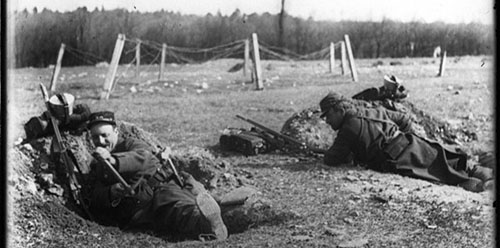
Both sides tried to outflank the other causing the system of trenches to extend from the Swiss border
 to the North Sea
to the North Sea
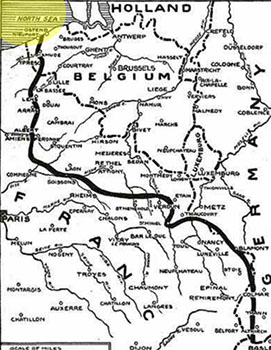 - over 500 miles in length. The result was the Western Front and trench warfare.
- over 500 miles in length. The result was the Western Front and trench warfare.
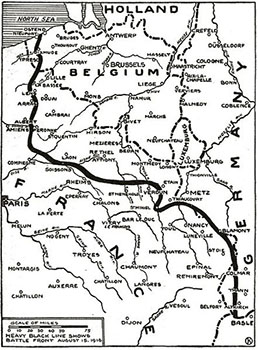
500 Miles of Trenches
What was life like in the trench? Experience it yourself with the Over the Top Interactive adventure to learn about the 500 miles of trenches that created a stalemate along the Front and what it was like for the men who lived in them. Be familiar with the poem and the information about going “over the top” for your exam!
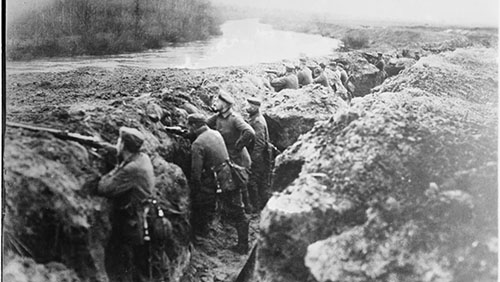
Watch the video IVM Life in the Trenches (8:59) to view what life was like for the soldiers in the trenches.
Open IVM Life in the Trenches in a new window
“Life in the Trenches WW1” by Imperial War Museums is licensed under CC BY ND.
Note: The presentation may take a moment to load.
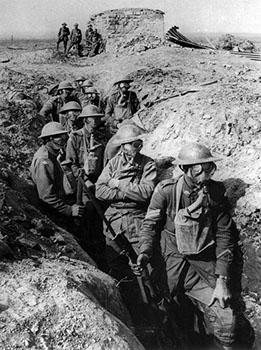
The Battle of Jutland
World War I had only one major naval Battle. Read more about The Battle of Jutland.
Two-Front War
Sandwiched between two enemies—France and Russia—Germany was forced into a two-front war. As you continue to study the war, use The National WWI Museum Interactive Timeline to guide you through the course of the war. It will be a great review resource.
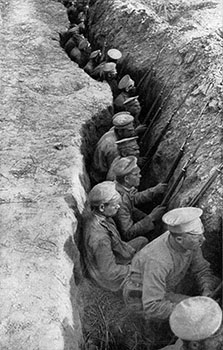
Rasputin
Meanwhile, things were not going well in Russia. Czar Nicholas II was not decisive and had been facing challenges from the peasants for his unpopular decisions. He joined his troops in war and saw Russia defeated at the battle of Tanneberg. He and his wife were heavily influenced by a controversial advisor named Rasputin. Read more about this at The Murder of Rasputin.
Even without the influence of Rasputin, Nicholas II and his family faced challenged from the public. Food shortages led to demonstrations and protests. Czar Nicholas II abdicated the throne and his brother refused the crown. The Provisional Government that replaced him was eventually replaced by the Bolsheviks and Lenin. The Romanovs, held captive by the Bolsheviks, were killed on July 17, 1918.
Russia
Russia, having lost their Czar Nicholas II and royal Romanov family to assassination and having been taken over by the Bolsheviks, opted out the war through the Treaty of Brest-Litovsk in early 1918. Defaulting on their earlier commitments to the Triple Entente
France, Russia, Great Britain
, they were subjected to a forced peace with the Central Powers
Germany, Austria-Hungary, Bulgaria, Ottoman Empire
that took a large portion of their land
 .
.

Armistice Day
As you have seen, the war began in August of 1914, and it did not end until 11th hour of the 11th day of the 11th month of 1918 - then known as Armistice Day but now celebrated as Veterans’ Day.
What caused the Allies to win the war?
Why did the United States, who had intended to remain neutral, enter the war on the side of the Allies in April of 1917?

Reasons the United States Entered the War
Over the course of the war, the Germans used their U-boats submarine to attack any ships that were traveling to Britain, to seize their cargoes and to sink the ships. Americans were still trading with Great Britain and the Germans were sinking their ships. Read Germans unleash U-boats to find out how they were used in unrestricted warfare.
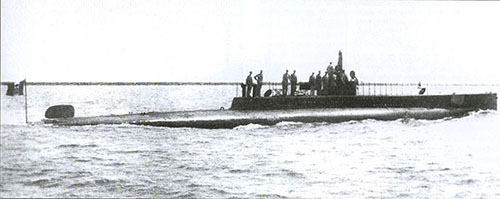
In addition, the British luxury ocean liner The Lusitania was sunk by the Germans off the coast of Ireland.

Then the British leaked information about the discovery of the Zimmerman Telegram (see the coded message and read the decoded message) from the German foreign minister to the Mexican government promising them parts of the United States’ territory in return for their support of Germany in the war.

These events caused President Woodrow Wilson to ask Congress to declare war on Germany. Watch The United States Enters World War I (3:40) for more on his decision.

New Technology
What new weapon technology was used in the Great War? Go to BBC BiteSize: Weapons Technology of WWI to learn about those weapons.